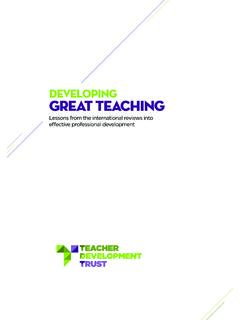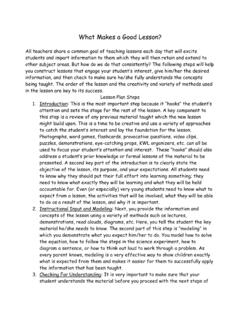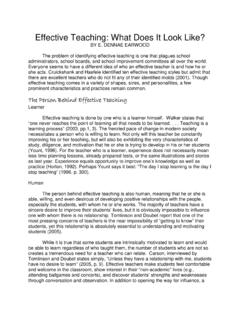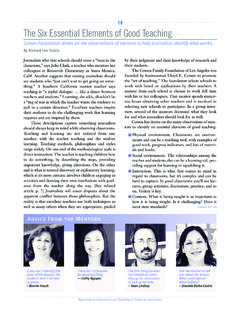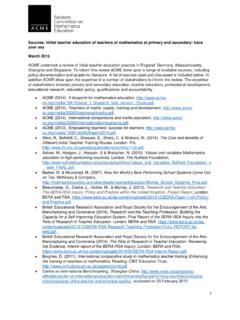Transcription of WHAT MAKES A GOOD LESSON - Northampton School for Girls
1 what MAKES A good LESSON ? Characteristics of a more than satisfactory LESSON The Recipe INGREDIENTS 1. A prompt start students greeted at the door and straight in to a routine task while other students arrive. 2. Brisk and quick register procedure (formal or informal) during the LESSON . Follow up on lateness and absence after LESSON . 3. The Intended Learning Objectives written on the board prior to LESSON starting. 4. Recap of previous learning elicited from students. 5. Reference to Learning Objectives discussed with students. 6. LESSON has pace not just lots of tasks students have opportunity to finish tasks. 7. good , lively display of stimulating material as well as student work. Keywords displayed and used in the LESSON . 8. LESSON has a variety of teaching/learning styles, but these always involve students interacting (sharing learning) with teacher and/or each other. 9. Student response to LESSON is differentiated (by task and/or resource) to pairs of students, small groups or individuals.
2 10. Teacher talk to whole class is minimal. 11. good teacher questioning used asking how? and why? to produce more insightful thinking and learning. 12. Celebrate student achievement with appropriate language. 13. Using student evaluation of peer work. 14. Stop and recap learning during LESSON . 15. End of LESSON has a plenary/recap or feedback five minutes what have we learned in today s LESSON ? 16. Students leave in a quiet and calm, orderly way at the end of the LESSON with teacher seeing them onto the corridor. LESSON PLANS Contain Planned Learning Outcomes. Schedule the LESSON into time segments. Contain reference to Unit of Work (eg Week 2, LESSON 1) and Unit of Work is attached. Contain information about homework; differentiation; individual students needs. Student data attached (Reading ages, CAT scores, SEN Levels, Key Stage scores, GCSE potential and estimated grades) as relevant and cross-referenced to LESSON plan (differentiation).
3 METHOD Consistent application of agreed procedures (eg Behaviour Management and A5 documents) Don t stop the learning of the majority to confront the behaviour of one or two. Characteristics of a well-taught LESSON The Recipe INGREDIENTS 1. A very prompt start students greeted at the door and straight in to a routine task while all other students arrive. 2. Brisk and quick register procedure (formal or informal) during the LESSON . Follow up on lateness and absence after LESSON . 3. The Intended Learning Objectives written on the board prior to LESSON starting, with reference to NC Level or GCSE grade. 4. Recap of previous learning elicited from students. 5. Reference to Learning Objectives discussed with students. 6. LESSON has pace not just lots of tasks students have opportunity to finish tasks. 7. Students know National Curriculum Level or GCSE grade to which the work is aiming. 8. good , lively display of stimulating material as well as student work.
4 Keywords displayed and used in the LESSON . 9. LESSON has a variety of teaching/learning styles, but these always involve students interacting (sharing learning) with teacher and/or each other. 10. Student response to LESSON is differentiated (by task and/or resource) to pairs of students, small groups or individuals. 11. Teacher talk to whole class is minimal. 12. good teacher questioning used asking how? and why? to produce more insightful thinking and learning. 13. Student achievement is celebrated with appropriate language. 14. Student evaluation of peer work is used. 15. Learning is recapped during LESSON . 16. End of LESSON has a plenary/recap or feedback five minutes what have we learned in today s LESSON ? 17. Students leave in a quiet and calm, orderly way at the end of the LESSON with teacher seeing them onto the corridor. LESSON PLANS Contain Planned Learning Outcomes.
5 Differation is detailed and levels indicated. Show ways in which students will be learning. The LESSON is scheduled into time-segments. Contain reference to Unit of Work (eg Week 2, LESSON 1) and Unit of Work is attached. Contain information about homework; differentiation; individual students needs. Student data attached (Reading ages, CAT scores, SEN Levels, Key Stage scores, GCSE potential and estimated grades) as relevant and cross-referenced to LESSON plan (differentiation). Contain evaluation of previous learning.




